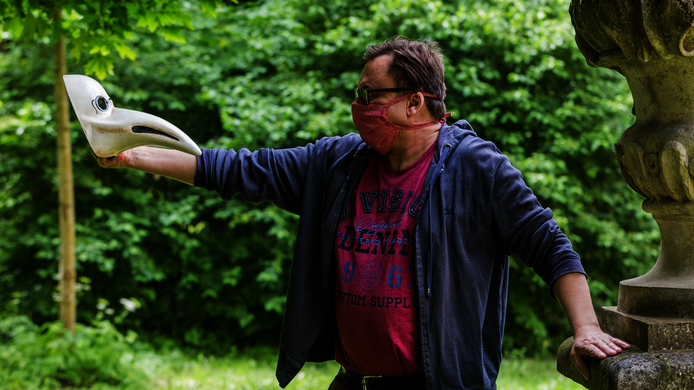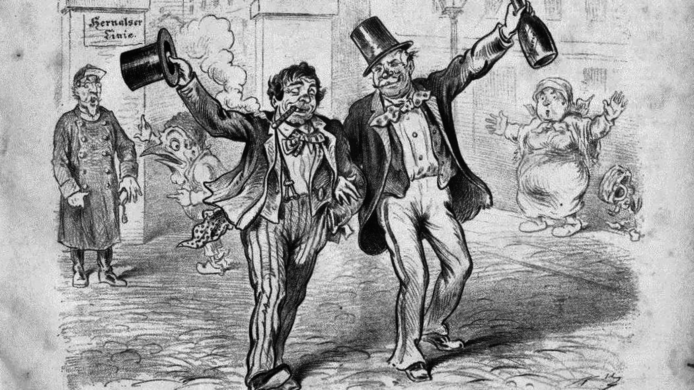Social distancing under the Habsburg Empire

HIV, SARS, Ebola and now corona: numerous epidemics in recent decades have shown that it is a fallacy to hope that humanity would finally overcome scourges such as these through technological progress. Time and again throughout history, epidemics decimated entire regions. The Spanish flu alone killed up to 50 million people between 1918 and 1920. Ever since human beings became sedentary, pathogens have found the breeding grounds they need to thrive in human civilisation. A case in point was the bacterium that made world history: Yersinia pestis, the bacterium causing the plague.
The “Black Death”
Between the Bronze Age and the end of the 19th century, several waves of plague swept across entire continents. In 1347, the Black Death came to Central Europe – probably on ships from the Near East. The port city of Caffa on the Crimean peninsula, today's Feodosia in the Ukraine, was one of the most important trading colonies of Genoa at that time. From there, the plague spread to Europe via the trade routes and, according to estimates, killed a third of Europe's population between 1347 and 1352.
Discovery of the bacterium
In the Middle Ages, the origin of the plague was still unknown. It was not until 1894 that the French physician Alexandre Yersin was able to prove that the disease was caused by bacterial infection, transmitted to fleas and humans by rats and other rodents.
First quarantine in Venice
Initially, the sick were taken to local hospitals without any special precautions; later the homes of plague sufferers were marked by a cross and those affected were forced to move off to accommodation outside the city. People became increasingly aware of the fact that the spread of the disease could be contained by isolating the sick. In the late 14th century, the first quarantine station was built on a Venetian island. As the Venetians suspected a connection between plague and maritime transport, travellers from ships were quarantined for 40 days – the term being derived from quaranta, denoting 40 in Italian.
Clean, tainted, foul
As a consequence, every free port had to have a quarantine station in compliance with the “Venetian lazaretto regime“. The regime provided for three categories: whenever a ship arrived, it was allocated a bill of health that was “clean”, “tainted” or “foul”. Foul meant there were already plague cases on board and tainted signified that it came from a port where there was a possible outbreak of the plague.
Germs – scientific theory on quarantine
A scientific theory underpinning the practice of isolation was not found until the 16th century. After observing the course of infectious diseases, the Italian physician Girolamo Fracastoro concluded that infection must occur via pathogens that attach themselves to surfaces and clothing. The measures to be taken against it: quarantine, keeping goods in storage, ventilation and fumigation. Until then, it had been believed since ancient times that diseases were transmitted via putrefaction processes in the air and water, so-called “miasmas”.

Military cordon against the plague
In addition to quarantines for ships, military cordons for sealing off a plague-contaminated area on land became increasingly important in early modern times. “From the 18th century onwards, the structures of the military cordon which had been created two centuries earlier as a line of defence against Ottoman incursions were used to ward off the plague,” notes Christian Promitzer. In a project funded by the Austrian Science Fund FWF, this historian from the University of Graz studied measures taken to combat infectious diseases such as the plague, cholera, smallpox, typhoid fever, malaria and syphilis in Southeast Europe between the Congress of Vienna in 1815 and the end of the First World War.
Social distancing under the Habsburg Empire
The largest quarantine building was to be found in Semlin, today's Zemun, a district of Belgrade. At that time Semlin was on Austrian territory and constituted the border with the Ottoman-held side of Belgrade. The “Kontumaz station” of Semlin – derived from the Italian contumàcia meaning quarantine – included buildings where goods traded between the Habsburg Empire and the Ottomans were stored for a certain period of isolation, as well as huts to accommodate people – segregated in groups – for the duration of their quarantine. “If they took a walk in the courtyard, they were not allowed to touch anyone from another group, otherwise the group that had already progressed further in the quarantine process would have had to start all over again,” says Promitzer, illustrating this early form of social distancing. Coins exchanged between Ottoman and Austrian traders also had to be placed in a vinegar solution for some time to be disinfected.
Cattle fording and Kontumaz forks
Another important part of quarantine measures in Semlin was the fording of livestock. Especially pigs, which were traded between Austria and the Ottoman Empire, had to cross the Sava or the Danube rivers. “It was hoped that traversing the water would cleanse them of livestock diseases,” explains Promitzer. In addition, all of the mail sent from the Ottoman Empire to the major European powers by land also passed through the quarantine station in Semlin and received special treatment: the letters were punctured and fumigated. The instrument used to hold them was the so-called Kontumaz fork. “Even today, if you look at letters from that time, you can still see the slits caused by this fork,” notes Promitzer.

Muslim pilgrims – a risk group
As of the mid-19th century, the Balkan Peninsula formed a “buffer zone” between the Austro-Hungarian Monarchy and the Ottoman Empire, which was considered a breeding ground for a variety of epidemics. Muslim pilgrims were also considered a special risk group contributing to the spread of epidemics. In 1865, cholera was brought to Constantinople from Egypt by Mecca pilgrims who had come into contact with Muslims from infected areas of India and Southeast Asia at the holy sites of Islam on the Arabian Peninsula. “For the Austro-Hungarian Monarchy, whose administration as of 1878 covered a considerable Muslim population in the former Ottoman province of Bosnia-Herzegovina, the annual pilgrimage to Mecca posed a real hygiene problem,” says Promitzer.
Quarantine as a disciplinary measure
Pilgrims returning to Europe were detained at the Suez Canal and placed in quarantine stations on the Sinai Peninsula. “Many Bosnian pilgrims tried to return to Europe by land in a caravan, because they feared Christian doctors at the stations might kill them,” explains Promitzer, who learned this from a report by an Austrian consul of the time. A physician, tasked with supervising the sanitary measures on site, reported rigid measures to which the Muslim pilgrims were subjected: they had to strip naked in front of Christian doctors, for instance, who then carried out medical examinations. “We should never lose sight of the disciplinary character of quarantines and the stigmatisation of specific groups,” Promitzer notes critically.
Cyclone B – against lice and Jews
This was the underlying idea that brought Promitzer, a Slavic specialist, a student of German and historian, to his field of research on epidemics in Southeast Europe. The starting point was the scholarly work of the British medical historian Paul Weindling, who did research into the development of the health system in Germany and Austria. He discovered that the Nazi regime tried to liken the Jewish population to lice that transmitted typhus. Cyclone B, an insecticide used to delouse buildings and clothing, was also used in the concentration camps’ gas chambers to kill Jews. Promitzer observed a similar phenomenon in Bulgaria: “The Muslim population was considered unhygienic and lice-infested, and one of the first disciplinary measures was shaving off their hair – a real affront, especially for Muslim women,” is the example Promitzer gives.
Surges of modernisation due to epidemics
Ever since a new type of virus appeared in China at the end of 2019, which was given the name Sars-CoV-2, researchers have been called upon to investigate this pathogen and forge full steam ahead with research on new drugs and vaccines. Previous epidemics also boosted research, as scientists searched for causes and debated countermeasures. “In the 19th century, a discussion that took place across the European continent as to whether the plague was really a bacterial disease or whether it was spread by miasmas – which would have meant relying less on quarantine and more on disinfection – led to reforms in hygiene,” comments Promitzer, an expert in the history of medicine.
Cholera - better waste disposal and sewerage
When the first cholera pandemic swept over Europe in 1830/31, claiming many lives and making it clear that quarantine was not the means to combat this disease, people began to use a microscope to look for the pathogen. The bacterium Vibrio cholerae was first described in 1854 by the Italian anatomist Filippo Pacini – a fact that went unnoticed by the public at large. One year later, the British physician John Snow recognised that the disease was transmitted via contaminated drinking water. “The lessons learned then led to improvements in waste disposal, sewerage systems and groundwater supplies in the cities,” the historian says in describing the modernisation steps that were triggered by the findings in cholera research.
Fake news in the past
In the same way that fake news, conspiracy theories and rumours are circulating in social networks today, fake news was also shared in the past: the Ottoman Empire was under widespread suspicion of constituting a breeding ground for the plague. “Although in the mid-19th century it was certain that no plague had been found in the Ottoman Empire for more than ten years, there were constantly false reports about this in the newspapers,” says Promitzer. In the 1850s, a plague commission of physicians appointed in Vienna travelled to Valona, now Vlorë in southern Albania, to investigate rumours of plague there. All they found was an epidemic rash.
Mass panic
In early 1879, a newspaper report caused an enormous stir when it became known that the plague had erupted in some villages in Astrakhan, Russia. The borders to Russia and the Balkans were sealed off for fear that the disease could spread as far as Austria. That mass panic proved to be exaggerated, as the epidemic soon died out where it started. This episode probably illustrates how much fear of this particular disease had taken hold in people's minds. This legacy remains evident in everyday speech: one “avoids something like the plague” or “calls down a plague on someone”.
From infectious disease to lifestyle diseases
In his research into epidemics, Christian Promitzer explores a topic that has influenced people's daily lives for thousands of years, as infectious diseases were the major cause of death for a long time. “People died from diseases such as typhoid fever, cholera and the plague. It was not until the second half of the 20th century that infections as the major cause of death were definitively replaced in developed countries by lifestyle diseases such as cardiovascular diseases,” notes Promitzer. But when a new virus appears, such as the coronavirus in late 2019, we see how vulnerable even our high-tech civilisation is, and how much people’s daily lives can suddenly be affected by it: e.g. when they are in isolation, have to engage in social distancing and wear face masks. And, who knows, maybe the “baby elephant” will make its way into our vocabulary as a unit of measurement.
Personal details
The historian Christian Promitzer is an assistant professor at the University of Graz. His research interests lie in the history of Southeast Europe, the social history of medicine, ethnic relationships in Southeast Europe and the history of Slovenia and Bulgaria. In a research project funded by the Austrian Science Fund FWF, he investigated the fight against infectious diseases and the healthcare system in Southeast Europe from the early 19th century until the end of World War I. With FWF funding he also conducted research into hidden minorities between Central Europe and the Balkans. Christian Promitzer, who is 58 years old, majored in Slavic Studies, German and History at the University of Graz and speaks the Slavic languages of Southeast Europe.





